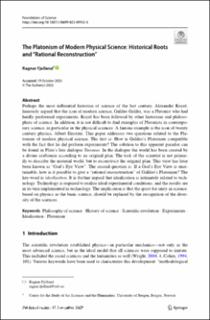| dc.description.abstract | Perhaps the most influential historian of science of the last century, Alexandre Koyré, famously argued that the icon of modern science, Galileo Galilei, was a Platonist who had hardly performed experiments. Koyré has been followed by other historians and philosophers of science. In addition, it is not difficult to find examples of Platonists in contemporary science, in particular in the physical sciences. A famous example is the icon of twenty century physics, Albert Einstein. This paper addresses two questions related to the Platonism of modern physical science. The first is: How is Galileo’s Platonism compatible with the fact that he did perform experiments? The solution to this apparent paradox can be found in Plato’s late dialogue Timaeus. In the dialogue the world has been created by a divine craftsman according to an original plan. The task of the scientist is not primarily to describe the material world, but to reconstruct the original plan. This view has later been known as “God’s Eye View”. The second question is: If a God’s Eye View is unattainable, how is it possible to give a “rational reconstruction” of Galileo’s Platonism? The key-word is idealisation. It is further argued that idealisation is intimately related to technology. Technology is required to realize ideal experimental conditions, and the results are in its turn implemented in technology. The implication is that the quest for unity in science, based on physics as the basic science, should be replaced by the recognition of the diversity of the sciences. | en_US |

